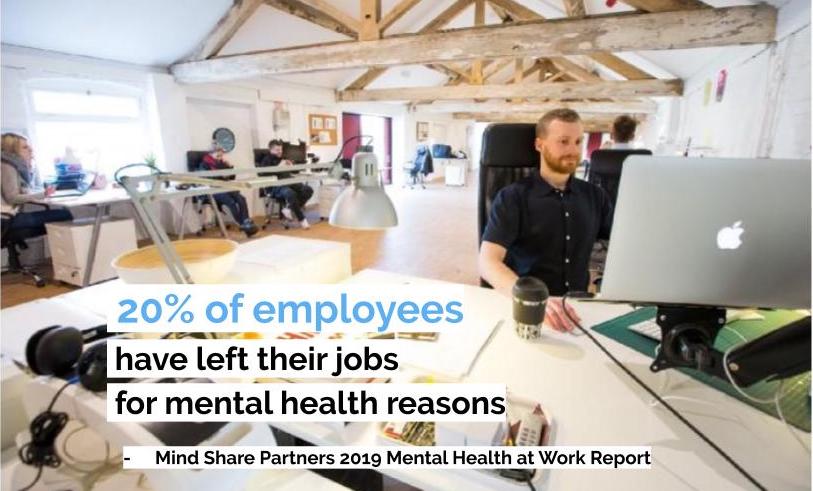The average person waits 8 to 10 years to get help for a mental health condition. That’s nearly a decade of symptoms–unaddressed and untreated–before someone decides to seek support. It would be preposterous for many of us to consider not getting any help if we’ve had a cold for over a month, let alone a decade. But for mental health, it’s the norm.
The majority of employees will experience symptoms of a mental health condition this year, and most of them aren’t seeking treatment often because of the strong stigma associated with mental health. Employers, thankfully, are starting to wake up to this fact and seeking ways to answer their employees’ calls for more mental health resources.
The need for mental health in the workplace isn’t new
For many companies, the initial response is to hand the issue off to HR to benchmark and acquire more mental health services; to find places and ways for employees to get access to mental health care.
What most employers are forgetting, however, is that access to mental health care at work isn’t new. EAPs have long been established as a way for employees to access easy mental health care. But despite the prevalence of EAPs, their utilization rates are abysmal, below 5%. Certainly, there are a myriad of reasons for this, including varying quality and long wait times, but one conclusion sticks—providing access to care does not guarantee that people will access the care.
The solution requires both access and acceptance

It takes more than access to solve mental health. It takes social acceptance. It takes reducing the strong stigma associated with mental health conditions and symptoms. Eight out of ten employees won’t seek treatment for mental health because of fear and shame—regardless of treatment options.
Only when we have acceptance and access in our workplaces will people seek the treatment they need to be healthy, happy, and engaged at work.
Studies in parental and family-oriented policies showed that when workplaces had a culture of acceptance around those policies, people were more likely to use them. The same holds true of mental health—if a person feels that their mental health symptoms make them weak, ineffective, or at risk of professional repercussions, they are unlikely to admit a challenge, let alone seek support. However, if a person knows that their company supports mental health and that it’s a safe topic, they are much more likely to use the resources available.
Learn to name, normalize, and navigate mental health at work
At Mind Share Partners, we teach company leaders the three pillars of creating a mentally healthy culture: name, normalize, and navigate.

Name Mental Health
Many companies assume that mental health is covered by talking about wellness, stress, or burnout—however,
only naming “stress” and “wellness” can actually further increase stigma by alienating people who are managing a condition.
We encourage companies to learn to use “mental health” language openly and incorporate mental health language into your policies, practices, and existing initiatives. Encourage senior leadership to speak out for mental health—if mental health is owned only by HR, employees are less likely to trust the messaging.
Normalize Mental Health
Make mental health a safe topic. Create a shared understanding of the prevalence and impact of mental health at work, while sparking open dialogue and providing concrete, follow-on discussion tools. Use storytelling and training to teach employees that mental health is equally prevalent across all levels of an organization and affects all communities. Consider establishing a mental health ERG or peer support program to sustain grassroots support and get feedback.
Navigate Mental Health
Train managers how to be both compassionate humans and compliant professionals (they are asking for it!) and to model healthy behaviors. Take steps to create adaptive workplaces that allow people to be at their best. Make sure employees know how to access support options and include mental health-related questions into your engagement surveys. Incorporate mental health into your inclusion strategy, and consider the effects of mental health across different communities.
Consider the benefits
The research is clear: employees who are mentally healthy are happier, more productive, and more likely to stick around. As the war for talent continues, companies who take proactive steps towards creating a mentally healthy culture, in addition to treatment access, will find themselves in the right place to attract and retain the best teams. Learn more here if you are ready to take the next step in mental health culture.


